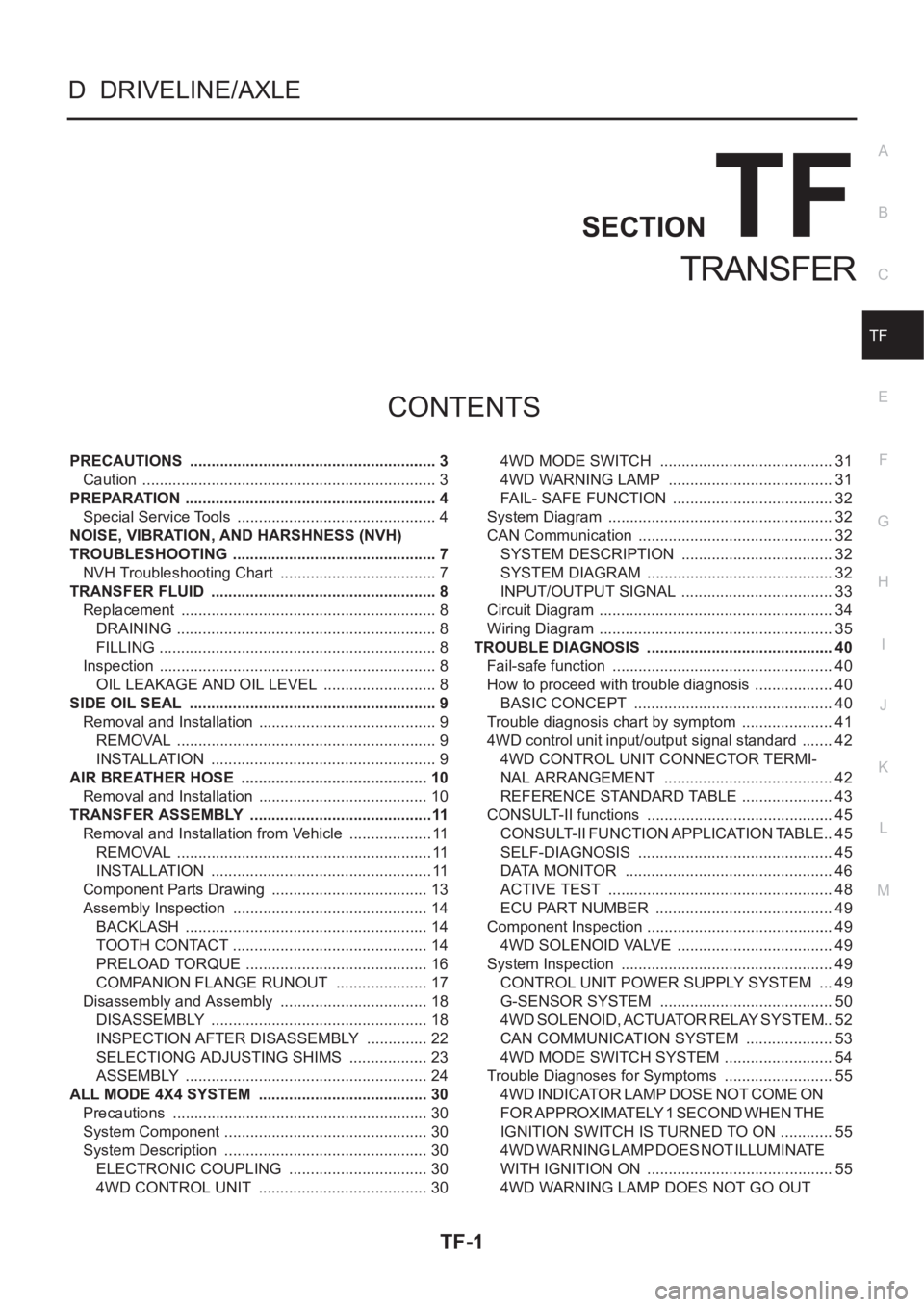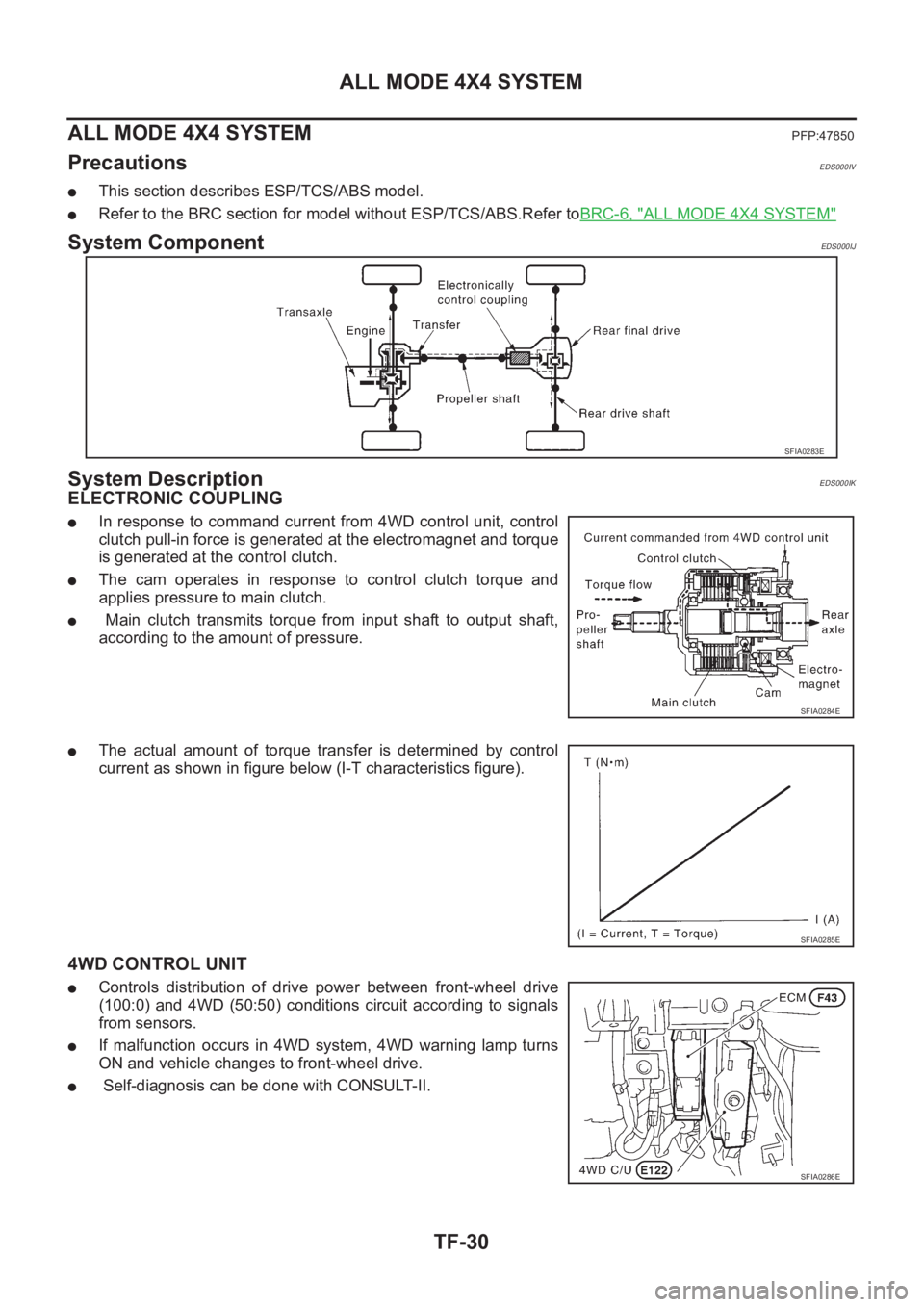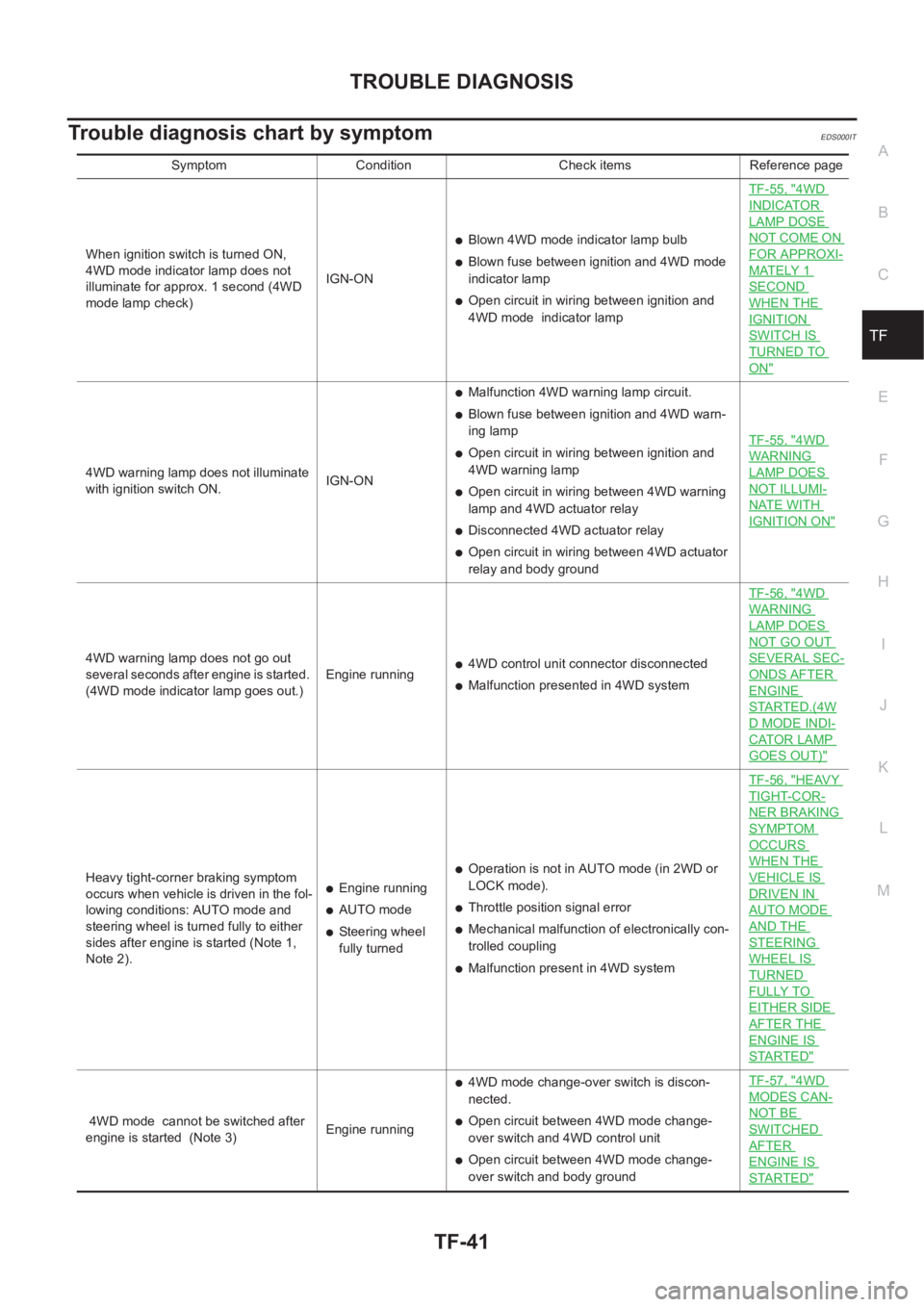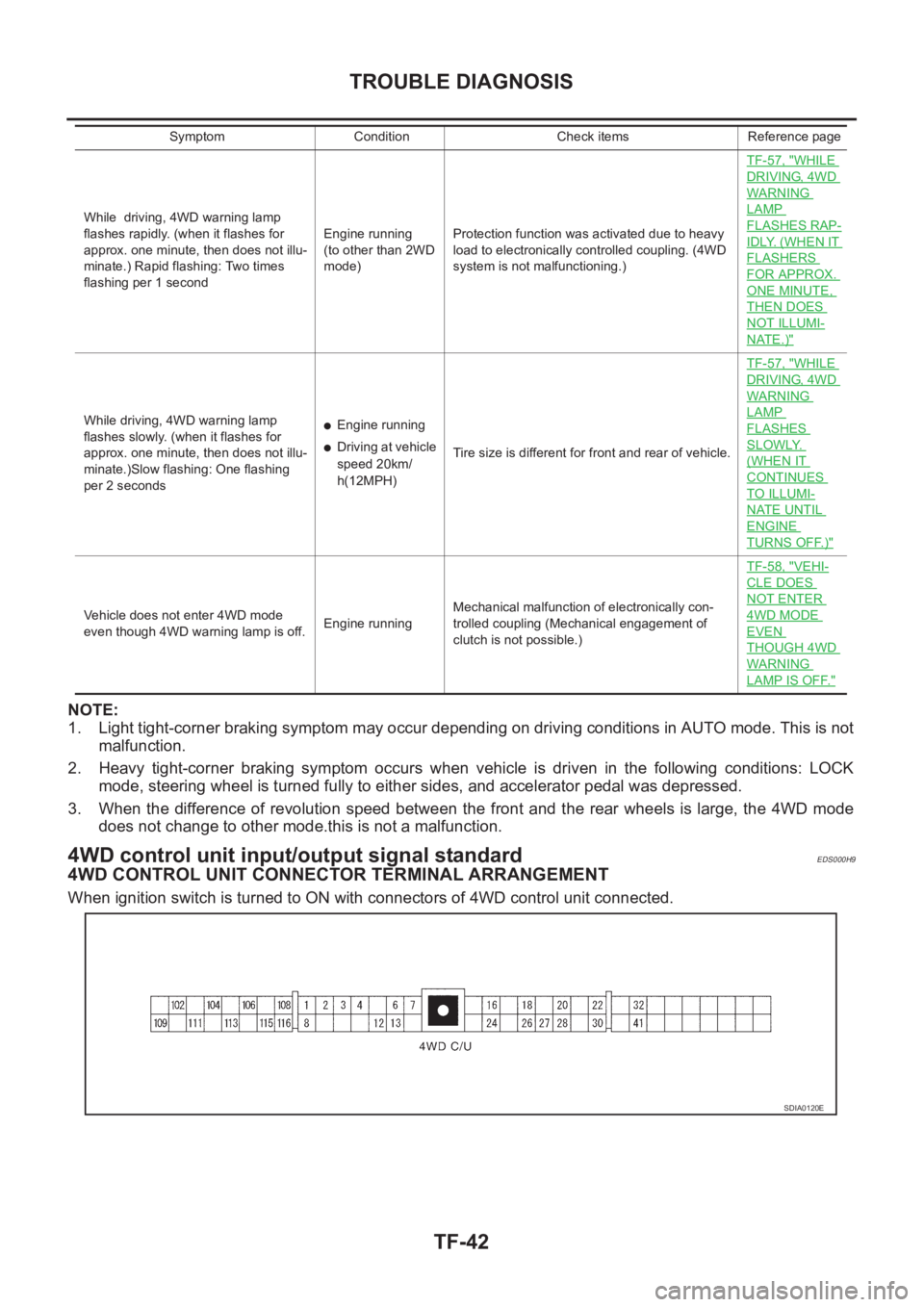2001 NISSAN X-TRAIL turn signal
[x] Cancel search: turn signalPage 2478 of 3833
![NISSAN X-TRAIL 2001 Service Repair Manual AT-400
[ALL]
LINE PRESSURE SOLENOID VALVE
3. CHECK POWER SOURCE CIRCUIT
1. Turn ignition switch to “OFF” position.
2. Check resistance between terminal 4 and TCM harness connector terminal 1.
If O NISSAN X-TRAIL 2001 Service Repair Manual AT-400
[ALL]
LINE PRESSURE SOLENOID VALVE
3. CHECK POWER SOURCE CIRCUIT
1. Turn ignition switch to “OFF” position.
2. Check resistance between terminal 4 and TCM harness connector terminal 1.
If O](/manual-img/5/57405/w960_57405-2477.png)
AT-400
[ALL]
LINE PRESSURE SOLENOID VALVE
3. CHECK POWER SOURCE CIRCUIT
1. Turn ignition switch to “OFF” position.
2. Check resistance between terminal 4 and TCM harness connector terminal 1.
If OK, check harness for short to ground and short to power.
3. Reinstall any part removed.
OK or NG
OK >> GO TO 4.
NG >> Repair open circuit or short to ground or short to power
in harness or connectors.
4. CHECK DTC
Perform Self-diagnosis Code confirmation procedure. Refer to AT- 3 9 6 , "
SELF-DIAGNOSIS CODE CONFIR-
MATION PROCEDURE" .
OK or NG
OK >>INSPECTION END
NG >> 1. Perform TCM input/output signal inspection.
2. If NG, recheck TCM pin terminals for damage or loose connection with harness connector. Resistance: Approx. 0Ω
SCIA0743E
Page 2483 of 3833
![NISSAN X-TRAIL 2001 Service Repair Manual CAN COMMUNICATION LINE
AT-405
[ALL]
D
E
F
G
H
I
J
K
L
MA
B
AT
Diagnostic ProcedureECS004UN
1.CHECK CAN COMMUNICATION CIRCUIT
With CONSULT-II
1. Turn ignition switch to “ON” position. (Do not start NISSAN X-TRAIL 2001 Service Repair Manual CAN COMMUNICATION LINE
AT-405
[ALL]
D
E
F
G
H
I
J
K
L
MA
B
AT
Diagnostic ProcedureECS004UN
1.CHECK CAN COMMUNICATION CIRCUIT
With CONSULT-II
1. Turn ignition switch to “ON” position. (Do not start](/manual-img/5/57405/w960_57405-2482.png)
CAN COMMUNICATION LINE
AT-405
[ALL]
D
E
F
G
H
I
J
K
L
MA
B
AT
Diagnostic ProcedureECS004UN
1.CHECK CAN COMMUNICATION CIRCUIT
With CONSULT-II
1. Turn ignition switch to “ON” position. (Do not start engine.)
2. Select “DATA MONITOR” mode for “A/T” with CONSULT-II.
3. The “CON COMM CIRCUIT” is detected.
Ye s o r N o ?
Yes >> Print out CONSULT-II screen, GO TO 2.
NG >>INSPECTION END
2.CHECK CAN COMMUNICATION SIGNALS
With CONSULT-II
1. Turn ignition switch to “ON” position. (Do not start engine.)
2. Select “CAN COMM SIGNALS” in “DATA MONITOR” mode for “A/T” with CONSULT-II.
>> Print out CONSULT-II screen, go to LAN-5, "
CAN SYSTEM (FOR A/T MODELS)"
CAN Communication Signals
PCIA0061E
Normal conditions Abnormal conditions (examples)
CAN COMM: OK CAN COMM: OK
CAN CIRC 1: OK CAN CIRC 1: UNKWN
CAN CIRC 2: OK CAN CIRC 2: UNKWN
CAN CIRC 3: OK CAN CIRC 3: UNKWN
CAN CIRC 4: OK CAN CIRC 4: UNKWN
CAN CIRC 5: UNKWN CAN CIRC 5: UNKWN
Page 2487 of 3833
![NISSAN X-TRAIL 2001 Service Repair Manual A/T SHIFT LOCK SYSTEM
AT-409
[ALL]
D
E
F
G
H
I
J
K
L
MA
B
AT
5.CHECK INPUT SIGNAL A/T DEVICE
Turn ignition switch to “OFF” position.
●Check voltage between A/T device harness connector M58 termi NISSAN X-TRAIL 2001 Service Repair Manual A/T SHIFT LOCK SYSTEM
AT-409
[ALL]
D
E
F
G
H
I
J
K
L
MA
B
AT
5.CHECK INPUT SIGNAL A/T DEVICE
Turn ignition switch to “OFF” position.
●Check voltage between A/T device harness connector M58 termi](/manual-img/5/57405/w960_57405-2486.png)
A/T SHIFT LOCK SYSTEM
AT-409
[ALL]
D
E
F
G
H
I
J
K
L
MA
B
AT
5.CHECK INPUT SIGNAL A/T DEVICE
Turn ignition switch to “OFF” position.
●Check voltage between A/T device harness connector M58 terminal 7 and ground.
OK or NG
OK >> GO TO 7.
NG >> GO TO 6.
6.DETECT MALFUNCTIONING ITEM
Check the following items:
1. Harness for short or open between battery and stop lamp switch harness connector 1
2. Harness for short or open between stop lamp switch harness connector 2 and A/T device harness con-
nector 7
3. Fuse
4. Stop lamp switch
–Check continuity between stop lamp switch harness connector M12 terminals 1 (R/Y) and 2 (P).
Check stop lamp switch after adjusting brake pedal — refer to BR-6, "
BRAKE PEDAL" .
OK or NG
OK >> GO TO 7.
NG >> Repair or replace damaged parts. Voltage:
Brake pedal depressed:
Battery voltage
Brake pedal released:
0V
SCIA1166E
SAT661K
Page 2489 of 3833
![NISSAN X-TRAIL 2001 Service Repair Manual A/T SHIFT LOCK SYSTEM
AT-411
[ALL]
D
E
F
G
H
I
J
K
L
MA
B
AT
10.CHECK SHIFT LOCK OPERATION
1. Reconnect shift lock harness connector.
2. Turn ignition switch from “OFF” to “ON” position. (Do n NISSAN X-TRAIL 2001 Service Repair Manual A/T SHIFT LOCK SYSTEM
AT-411
[ALL]
D
E
F
G
H
I
J
K
L
MA
B
AT
10.CHECK SHIFT LOCK OPERATION
1. Reconnect shift lock harness connector.
2. Turn ignition switch from “OFF” to “ON” position. (Do n](/manual-img/5/57405/w960_57405-2488.png)
A/T SHIFT LOCK SYSTEM
AT-411
[ALL]
D
E
F
G
H
I
J
K
L
MA
B
AT
10.CHECK SHIFT LOCK OPERATION
1. Reconnect shift lock harness connector.
2. Turn ignition switch from “OFF” to “ON” position. (Do not start engine.)
3. Recheck shift lock operation.
OK or NG
OK >>INSPECTION END
NG >> GO TO 11.
11 . CHECK A/T DEVICE INSPECTION
1. Perform A/T device input/output signal inspection test.
2. If NG, recheck harness connector connection.
OK or NG
OK >>INSPECTION END
NG >> Repair or replace damaged parts.
Page 2611 of 3833

TF-1
TRANSFER
D DRIVELINE/AXLE
CONTENTS
C
E
F
G
H
I
J
K
L
M
SECTION
A
B
TF
TRANSFER
PRECAUTIONS .......................................................... 3
Caution ..................................................................... 3
PREPARATION ........................................................... 4
Special Service Tools ............................................... 4
NOISE, VIBRATION, AND HARSHNESS (NVH)
TROUBLESHOOTING ................................................ 7
NVH Troubleshooting Chart ..................................... 7
TRANSFER FLUID ..................................................... 8
Replacement ............................................................ 8
DRAINING ............................................................. 8
FILLING ................................................................. 8
Inspection ................................................................. 8
OIL LEAKAGE AND OIL LEVEL ........................... 8
SIDE OIL SEAL .......................................................... 9
Removal and Installation .......................................... 9
REMOVAL ............................................................. 9
INSTALLATION ..................................................... 9
AIR BREATHER HOSE ............................................ 10
Removal and Installation ........................................ 10
TRANSFER ASSEMBLY ...........................................11
Removal and Installation from Vehicle .................... 11
REMOVAL ............................................................ 11
INSTALLATION .................................................... 11
Component Parts Drawing ..................................... 13
Assembly Inspection .............................................. 14
BACKLASH ......................................................... 14
TOOTH CONTACT .............................................. 14
PRELOAD TORQUE ........................................... 16
COMPANION FLANGE RUNOUT ...................... 17
Disassembly and Assembly ................................... 18
DISASSEMBLY ................................................... 18
INSPECTION AFTER DISASSEMBLY ............... 22
SELECTIONG ADJUSTING SHIMS ................... 23
ASSEMBLY ......................................................... 24
ALL MODE 4X4 SYSTEM ........................................ 30
Precautions ............................................................ 30
System Component ................................................ 30
System Description ................................................ 30
ELECTRONIC COUPLING ................................. 30
4WD CONTROL UNIT ........................................ 304WD MODE SWITCH ......................................... 31
4WD WARNING LAMP ....................................... 31
FAIL- SAFE FUNCTION ...................................... 32
System Diagram ..................................................... 32
CAN Communication ...........................................
... 32
SYSTEM DESCRIPTION .................................... 32
SYSTEM DIAGRAM ............................................ 32
INPUT/OUTPUT SIGNAL .................................... 33
Circuit Diagram ....................................................... 34
Wiring Diagram ....................................................... 35
TROUBLE DIAGNOSIS ............................................ 40
Fail-safe function .................................................... 40
How to proceed with trouble diagnosis ................... 40
BASIC CONCEPT ............................................... 40
Trouble diagnosis chart by symptom ...................... 41
4WD control unit input/output signal standard ........ 42
4WD CONTROL UNIT CONNECTOR TERMI-
NAL ARRANGEMENT ........................................ 42
REFERENCE STANDARD TABLE ...................... 43
CONSULT-II functions ............................................ 45
CONSULT-II FUNCTION APPLICATION TABLE ... 45
SELF-DIAGNOSIS .............................................. 45
DATA MONITOR ................................................. 46
ACTIVE TEST ..................................................... 48
ECU PART NUMBER .......................................... 49
Component Inspection ............................................ 49
4WD SOLENOID VALVE ..................................... 49
System Inspection .................................................. 49
CONTROL UNIT POWER SUPPLY SYSTEM .... 49
G-SENSOR SYSTEM ......................................... 50
4WD SOLENOID, ACTUATOR RELAY SYSTEM ... 52
CAN COMMUNICATION SYSTEM ..................... 53
4WD MODE SWITCH SYSTEM .......................... 54
Trouble Diagnoses for Symptoms .......................... 55
4WD INDICATOR LAMP DOSE NOT COME ON
FOR APPROXIMATELY 1 SECOND WHEN THE
IGNITION SWITCH IS TURNED TO ON ............. 55
4WD WARNING LAMP DOES NOT ILLUMINATE
WITH IGNITION ON ............................................ 55
4WD WARNING LAMP DOES NOT GO OUT
Page 2640 of 3833

TF-30
ALL MODE 4X4 SYSTEM
ALL MODE 4X4 SYSTEM
PFP:47850
PrecautionsEDS000IV
●This section describes ESP/TCS/ABS model.
●Refer to the BRC section for model without ESP/TCS/ABS.Refer toBRC-6, "ALL MODE 4X4 SYSTEM"
System ComponentEDS000IJ
System DescriptionEDS000IK
ELECTRONIC COUPLING
●In response to command current from 4WD control unit, control
clutch pull-in force is generated at the electromagnet and torque
is generated at the control clutch.
●The cam operates in response to control clutch torque and
applies pressure to main clutch.
● Main clutch transmits torque from input shaft to output shaft,
according to the amount of pressure.
●The actual amount of torque transfer is determined by control
current as shown in figure below (I-T characteristics figure).
4WD CONTROL UNIT
●Controls distribution of drive power between front-wheel drive
(100:0) and 4WD (50:50) conditions circuit according to signals
from sensors.
●If malfunction occurs in 4WD system, 4WD warning lamp turns
ON and vehicle changes to front-wheel drive.
● Self-diagnosis can be done with CONSULT-II.
SFIA0283E
SFIA0284E
SFIA0285E
SFIA0286E
Page 2651 of 3833

TROUBLE DIAGNOSIS
TF-41
C
E
F
G
H
I
J
K
L
MA
B
TF
Trouble diagnosis chart by symptomEDS000IT
Symptom Condition Check items Reference page
When ignition switch is turned ON,
4WD mode indicator lamp does not
illuminate for approx. 1 second (4WD
mode lamp check)IGN-ON
●Blown 4WD mode indicator lamp bulb
●Blown fuse between ignition and 4WD mode
indicator lamp
●Open circuit in wiring between ignition and
4WD mode indicator lampTF-55, "
4WD
INDICATOR
LAMP DOSE
NOT COME ON
FOR APPROXI-
MATELY 1
SECOND
WHEN THE
IGNITION
SWITCH IS
TURNED TO
ON"
4WD warning lamp does not illuminate
with ignition switch ON.IGN-ON
●Malfunction 4WD warning lamp circuit.
●Blown fuse between ignition and 4WD warn-
ing lamp
●Open circuit in wiring between ignition and
4WD warning lamp
●Open circuit in wiring between 4WD warning
lamp and 4WD actuator relay
●Disconnected 4WD actuator relay
●Open circuit in wiring between 4WD actuator
relay and body groundTF-55, "
4WD
WARNING
LAMP DOES
NOT ILLUMI-
NATE WITH
IGNITION ON"
4WD warning lamp does not go out
several seconds after engine is started.
(4WD mode indicator lamp goes out.)Engine running●4WD control unit connector disconnected
●Malfunction presented in 4WD systemTF-56, "
4WD
WARNING
LAMP DOES
NOT GO OUT
SEVERAL SEC-
ONDS AFTER
ENGINE
STARTED.(4W
D MODE INDI-
CATOR LAMP
GOES OUT)"
Heavy tight-corner braking symptom
occurs when vehicle is driven in the fol-
lowing conditions: AUTO mode and
steering wheel is turned fully to either
sides after engine is started (Note 1,
Note 2).●Engine running
●AUTO mode
●Steering wheel
fully turned
●Operation is not in AUTO mode (in 2WD or
LOCK mode).
●Throttle position signal error
●Mechanical malfunction of electronically con-
trolled coupling
●Malfunction present in 4WD systemTF-56, "
HEAVY
TIGHT-COR-
NER BRAKING
SYMPTOM
OCCURS
WHEN THE
VEHICLE IS
DRIVEN IN
AUTO MODE
AND THE
STEERING
WHEEL IS
TURNED
FULLY TO
EITHER SIDE
AFTER THE
ENGINE IS
STARTED"
4WD mode cannot be switched after
engine is started (Note 3)Engine running
●4WD mode change-over switch is discon-
nected.
●Open circuit between 4WD mode change-
over switch and 4WD control unit
●Open circuit between 4WD mode change-
over switch and body groundTF-57, "
4WD
MODES CAN-
NOT BE
SWITCHED
AFTER
ENGINE IS
STARTED"
Page 2652 of 3833

TF-42
TROUBLE DIAGNOSIS
NOTE:
1. Light tight-corner braking symptom may occur depending on driving conditions in AUTO mode. This is not
malfunction.
2. Heavy tight-corner braking symptom occurs when vehicle is driven in the following conditions: LOCK
mode, steering wheel is turned fully to either sides, and accelerator pedal was depressed.
3. When the difference of revolution speed between the front and the rear wheels is large, the 4WD mode
does not change to other mode.this is not a malfunction.
4WD control unit input/output signal standardEDS000H9
4WD CONTROL UNIT CONNECTOR TERMINAL ARRANGEMENT
When ignition switch is turned to ON with connectors of 4WD control unit connected.
While driving, 4WD warning lamp
flashes rapidly. (when it flashes for
approx. one minute, then does not illu-
minate.) Rapid flashing: Two times
flashing per 1 secondEngine running
(to other than 2WD
mode)Protection function was activated due to heavy
load to electronically controlled coupling. (4WD
system is not malfunctioning.)TF-57, "
WHILE
DRIVING, 4WD
WARNING
LAMP
FLASHES RAP-
IDLY. (WHEN IT
FLASHERS
FOR APPROX.
ONE MINUTE,
THEN DOES
NOT ILLUMI-
NATE.)"
While driving, 4WD warning lamp
flashes slowly. (when it flashes for
approx. one minute, then does not illu-
minate.)Slow flashing: One flashing
per 2 seconds●Engine running
●Driving at vehicle
speed 20km/
h(12MPH)Tire size is different for front and rear of vehicle.TF-57, "
WHILE
DRIVING, 4WD
WARNING
LAMP
FLASHES
SLOWLY.
(WHEN IT
CONTINUES
TO ILLUMI-
NATE UNTIL
ENGINE
TURNS OFF.)"
Vehicle does not enter 4WD mode
even though 4WD warning lamp is off.Engine runningMechanical malfunction of electronically con-
trolled coupling (Mechanical engagement of
clutch is not possible.)TF-58, "
VEHI-
CLE DOES
NOT ENTER
4WD MODE
EVEN
THOUGH 4WD
WARNING
LAMP IS OFF."
Symptom Condition Check items Reference page
SDIA0120E